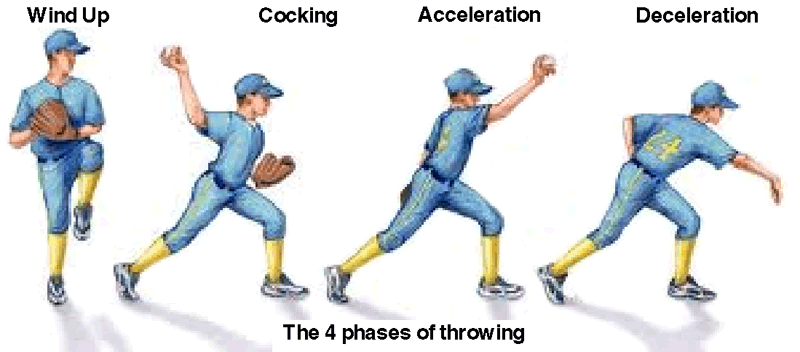UCL Sprains in the Overhead Athlete
Did you know? 60% of children and adolescents between 11 and 18 experience elbow injuries during or after pitching in organized baseball or softball games.
What is the UCL? The Ulnar Collateral Ligament (UCL) of the elbow is the primary elbow stabilizer and is critical for valgus stability. The UCL plays an important role in most throwing sports, including baseball and javelin, as well as racquet sports and ice hockey.
The UCL is composed of 3 bands: anterior, posterior, and transverse. The anterior band provides the major contribution to valgus stability.
Phases of Throwing
The acceleration phase of the overhead throw causes the greatest amount of valgus stress to the elbow. During the acceleration phase, the valgus stress can exceed the tensile strength of the UCL, causing either chronic microscopic tears or acute rupture. In some cases, it frays over time and eventually ruptures. In other cases, the pitcher can identify one pitch when it occurred.

Signs and Symptoms
- Medial elbow pain, especially during the acceleration phase of throwing.
- Chronic pain and may start to effect throwing ability.
- Rest generally helps to relieve the pain.
- Sometimes this pain is felt during a single throw, along with a popping sensation, which causes the athlete to discontinue throwing.
Elbow injuries in young athletes are generally chronic (long-term), with persistent pain and instability from repetitive overhead activities. The chance of a ligament injury can also be increased by an acute traumatic event such as an elbow dislocation. This can then lead to chronic pain and instability.
Assessment and Treatment
In order to correctly assess and treat this injury, it is essential for your Athletic Trainer to have a complete understanding of the anatomy and biomechanics of the elbow during the throwing motion.
MRI can be used in some cases to determine the extent of the sprain. However, several pitchers, especially those who have been pitching for a long time, have abnormal MRIs even when they’re symptom-free.
In most cases, a conservative rehabilitation can provide help heal the injury. Once symptoms resolve, the athlete begins a gradual throwing progression. In some cases, athletes can return to their sports without surgery.
If conservative treatment fails, then the athlete considers Tommy John surgery.
- Created by Dr. Frank Jobe and first performed in 1974. At the time, chance of success was 1 in 100.
- Today, 85-92% of operations are successful.
- Usually requires 1 year of rehab after surgery for pitchers or 6 months for position players.
- Throwing usually begins 16 weeks after surgery.
Myths and Misconceptions
Some players who have undergone TJ Surgery have reported throwing harder. Due to this there have been some cases in which uninjured athletes or their parents have requested Tommy John Surgery in hopes of improving performance. In most cases, improved results are due to better conditioning and the fact that the UCL usually is deteriorating for years before symptoms arise prior to needing surgery. There is no evidence that the surgery can improve performance and young athletes should not consider the procedure unless they are injured.
3747